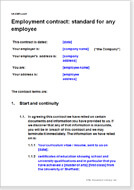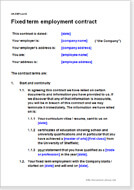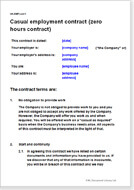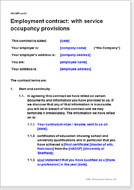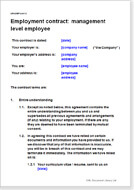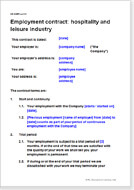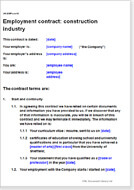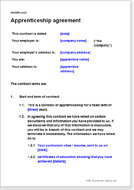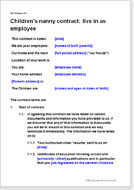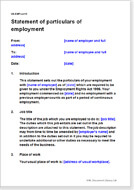Employment contracts
Many of the clauses in employment contracts are required by law, making one document likely to be very similar to another, even for a different role in a different industry. Look at our standard contract first (suitable for most employees), then decide whether you need the additional provisions that the other versions contain. We also have a selection of job specific agreements so as to save you time customising a template.
Employment contract: standard for any employee
A complete contract that balances strong protection for the employer organisation and a fair, transparent, deal for the employee.
The employee may be:
- in any position below director level
- full time, part time or temporary
The contract is suitable for any type of organisation.
The document provides an option for a trial period. In law, having a probation period does not change the rights of either the employee or the employer during or after the trial - the benefits of inclusion are motivation during the first months and fostering of goodwill if the hiring doesn't work as expected.
Fixed term employment contract
This is a comprehensive document for any organisation that employs staff on fixed term contracts.
It provides a superb framework for fair, full and easily understood protection of the employer and compliance with organisational and legal requirements.
Even though fixed term contracts expire after the term ends, the employer must still comply with the law relating to dismissal. However, the expiry of the fixed term is a 'reasonable reason' to dismiss someone who might otherwise claim that the dismissal was unfair.
If the term is for two years or longer, the employer must also follow the law relating to redundancy, whether for projects, seasonal increases in work or to cover full-time employees on leave.
Use this document for:
- short-term cover for another employee who is temporarily unavailable, for example, on maternity leave, a sabbatical, secondment or long term sickness
- cover for seasonal demand, for example in retail and agriculture
- workers for a specific project, for example in the film, construction and event management industries
Zero hours contract (casual employment contract)
This is a comprehensive contract for casual workers.
It is suitable for:
- any type of organisation within the UK: companies, charities, trusts, partnerships, governmental organisations and others
- employees performing any type of work: duties and training requirements can be added easily
A zero hours contract places no obligation on the employer to provide work. Pay, holiday entitlements and benefits are proportionate to hours worked.
The document contains absolutely up-to-date law and follows current best practice recommendations by ACAS and other related bodies.
Employment contract: with service occupancy provisions
This is our standard contract that additionally includes provision for service occupancy - that is where the employee is required to live on business premises in order to perform the job.
The type of property occupied is not important – it could be a single room with facilities shared with other employees, an annexed flat, or a separate building.
Example roles would be: caretaker, school housemaster, hotel staff, care industry staff, nanny or other household staff.
The document is suitable:
- for any type of organisation
- for full time, part time or temporary staff
Note: you should also use a residential licence to occupy in addition to this agreement.
Employment contract: management level employee
This is our standard contract, tailored for senior level staff who are not company directors. It is:
- suitable for use in any organisation: company, partnership, unincorporated business, charity
- very strong on protection of the employer's confidential information and the prevention of the employee from starting a competing business
It includes paragraphs for benefits likely to be given at a senior level including use of a company car and health insurance.
Unlike our standard contract, it excludes:
- a paragraph relating to collective agreements: since senior staff are unlikely to be members of labour unions
- a trial period
Employment contract: hospitality and leisure industry
This contract is a variation of our standard contract, tailored specifically for staff working in pubs, bars and restaurants, at events, receptions or parties, or otherwise in the hospitality and leisure industry.
It is suitable for any level of staff below the top level of management. Emphasised is the importance of quality customer service.
The contract provides for:
- producing and serving food and drinks (including alcoholic drinks), with a focus on hygiene and health and safety
- the employee to travel to different locations to work, including changing venues, if necessary
- flexible working and restraint of competitive trading
- working unsociable hours and opt out of the Working Time Regulations
Employment contract: construction industry
A contract tailored to workers in the construction industry: builders, brick layers, joiners, carpenters, plumbers, electricians, scaffolders or any other trade.
There is emphasis on having achieved levels of qualification necessary for the position.
The document is suitable for:
- qualified staff and part-qualified staff
- part- or full-time or employees
Apprenticeship agreement
Nearly all apprentices have to be hired under an employment contract that follows the prescribed format set out by the Apprenticeships (Form of Apprenticeship Agreement) Regulations 2012 and the Apprenticeship, Skills, Children and Learning Act 2009.
This contract follows that format and includes the required information to qualify as an apprenticeship agreement. It provides for fair and full protection of the employer and compliance with other employment law.
It can be used by employers in organisations of any size, and for employing apprentices of any age from 16 upwards.
Children's nanny contract: live in as employee
This is a contract for parents to use to employ a full-time, live-in nanny.
It covers the parents’ obligations as employers with appropriate provisions added for a nanny, such as:
- references and qualifications
- trial period
- hours and availability
- expenses
- parental absence arrangements
- emergency procedures
- liaison arrangements
- use of car
- arrangements for work outside the UK
- confidentiality of all parties
Statement of particulars of employment
Official statement of particulars containing key provisions regarding the agreement to be provided to an employee when they start working as an employee.

If the document isn’t right for your circumstances for any reason, just tell us and we’ll refund you in full immediately.

We avoid legal terminology unless necessary. Plain English makes our documents easy to understand, easy to edit and more likely to be accepted.

You don’t need legal knowledge to use our documents. We explain what to edit and how in the guidance notes included at the end of the document.

Email us with questions about editing your document. Use our Lawyer Assist service if you’d like our legal team to check your document will do as you intend.

Our documents comply with the latest relevant law. Our lawyers regularly review how new law affects each document in our library.
What is an employment contract?
An employment contract (also known as an employment agreement, contract of employment, or employee contract) sets out the employment conditions and the rights, responsibilities, and duties of the employer and the employee as agreed between them.
What should be included in an employment contract?
Employee and employer relationships are regulated in two ways: through contractual terms and by statutory law.
Employment rights and responsibilities
Statutory law provides the minimum level of employment rights guaranteed to each employee. These include, amongst others, the right to be granted the National Minimum Wage, the right to rest breaks, statutory sick pay, holiday pay, maternity leave, maternity pay, maximum working hours).
If any term of the employment agreement reduces the right granted to the employee by statutory law, that term will not be enforcable by a court or tribunal (e.g. if the employee contract grants a wage lesser than the National Minimum Wage or does not grant statutory sick pay to the employee). However, the employer can grant further rights if the employer desires to do so (such as a greater holiday allowance).Therefore, it is pertinent for employers and employees both to know what a contract of employment can and cannot cover.
Note: the Working Time Regulations provide that the legal maximum number of hours an employee can be required to work is 48 hours per week (including work for any other employers), unless the employee agrees to specifically opt out. If the employee does not opt out, you must take reasonable steps to ensure that the working time stays under the legal limit.
Statement of particulars of employment
To be compliant with the Employment Rights Act 1996, an employer must provide a statement of particulars of employment (also known as a principal statement) to all new hires. This document serves to make the new employee aware of certain important employment terms (such as start date, job title, entitlement to statutory sick pay, entitlement to holidays including public holidays, working hours, notice period for terminating the contract of employment, probationary period, end date if it is a fixed term employment, and pension scheme details).
A contract of employment itself can serve as the principal statement if the contract of employment covers all the points required.
All of our documents include all the necessary information to act as a written statement of employment particulars. You don’t need to provide this information separately in an additional document.
Organisational policies and procedures
Other policies and procedures that are not required to be provided in a written statement of particulars (such as data protection) could be included in the contract of employment. However, especially when you have many employees, changing each employment contract (and ensuring consistency between employees) every time a new law changes can be time consuming and difficult. Therefore, it is usual to place all procedures and policies common to all staff (including such things as general holiday entitlement, notice periods for paid leaves, pension scheme membership and grievance procedures) in an employee handbook and refer to the handbook in the contract of employment.
Our employment contract templates
Each Net Lawman employment contract template covers the terms required to comply with the law and also provisions that many employee contract templates do not contain.
Using one, you'll be able to create your own employment contract for your own business without needing to navigate extensive employment law.
While our employment contract templates provide extensive options and cover a wide range of possibilities, they are available for download in microsoft word format. So you will have no trouble editing the document to fit your needs.
Further terms of employment
We include terms in our employee contract templates that protect your business from, for example: purposeful or accidental intellectual property theft; and that reduce the likelihood of ever being called to tribunals by disgruntled employees.
Our employee contract templates are completely up-to-date with the law. We also follow best practice recommendations by ACAS and other bodies.
Easy to understand and edit
We use plain English and modern language throughout our employee contract templates.
Doing so makes clear your expectations for your employee without reducing the legal effect of the document. It has the additional advantage of making editing easy.
Details such as the employee's job title, employee duties and training provisions can be added in our employee contract templates if required, either within the existing text, or by reference to a job description.
You can amend employment terms in our documents to cater to a change in circumstances, provided the written consent of both parties is available.
Suitable for all businesses and organisations
Our employee contract templates can be used by any type of organisation (including companies, charities, trusts, partnerships, and governmental organisations) of any size and in any industry.
Suitable for:
- any new employee
- for updating existing employment agreement that does not comply with the latest law
- any level of employee (we provide fuller contracts for senior staff)
- permanent employees (full or part time employee) and temporary employees (such as zero hours workers)
Why is it important to have a written employment contract?
An employment contract, written or verbal is made as soon as the employee accepts a job offer. To minimise future misunderstandings, we recommend providing a written employment contract with the offer letter so that the new employee can return an acceptance letter with a signed copy of the contract of employment.
Different types of employee contracts
There are several different employment types. Each requires a slightly different employment contract.
Permanent employee: A permanent employee can be either part or full-time. A permanent employees’ employment continues for an indefinite duration unless the contract of employment is terminated by either party. If you want to hire a permanent employee, you can use our standard employment contract template
Fixed term employee: A fixed-term employee is a person whose contract of employment is due to end when a specified event does or does not happen or when a specified task has been completed. For hiring fixed term employees, use our fixed term employment contract template.
Causal employee: Causal employees are hired by employers on an ad hoc basis without any guarantee of continuous employment or a certain number of work hours. If you require a causal worker, use our zero hours employment contract template.
How does apprenticeship differ from employment?
Apprenticeship is differentiated from other types of employment. The contract of employment and operation are subject to the terms of the regulations of the National Apprenticeship Service (NAS). You cannot set up your own training scheme and call it an apprenticeship.
To encourage businesses to take on apprentices, Parliament passed The Apprenticeships, Skills, Children and Learning Act 2009, which included the power to prescribe a model apprenticeship agreement as a contract of service rather than a contract of apprenticeship.
Employment rights of an apprentice
The difference between contracts of employment and contracts of service is important because a contract of service can be terminated on notice, just like any other employment contract, without the apprentice being able to claim compensation for loss of training, for loss of status or for unpaid wages for the rest of the training period.
The actual model - the information that must be included to qualify as an apprenticeship agreement - is set out in The Apprenticeships (Form of Apprenticeship Agreement) Regulations 2012 and came into force on 6 April 2012.
Of course, many employers prefer to avoid the bureaucracy of the formal scheme and simply train their own less experienced employees in the way that best suits them.
When to use an apprenticeship agreement
You can use the apprenticeship scheme to train new and existing employees of any age, although most apprentices are young workers in a first job.
The advantage of taking on an apprentice as against a normal employee in a training scheme is that training costs are typically lower than through other training programmes.
If you are employing apprentices under the formal scheme, use our specific apprenticeship agreement. If you simply train your staff on the job, use our standard employment contract.
Our apprenticeship agreement
Our apprenticeship agreement strongly protects the employer’s confidentiality, information, and intellectual property.
It also provides for fair and full protection of the employer and compliance with other employment law. It includes the required information to qualify as an apprenticeship agreement.
All rights reserved

